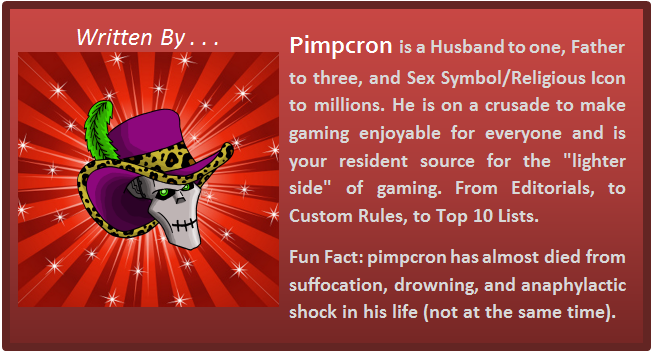40k: Breaking The Game



This is your old pal Pimpcron, with a philosophical look at what we call “Competitive” Wargaming. What is it really? Is it truly the ultimate test of someone’s battlefield mettle?
First of all let’s take a look at the ideas behind a balanced strategy game. The Game Designer creates Universal Rules that determine how the game is played that are absolutely unbreakable and irrevocable . . . until they decide to break and revoke them. (Does Congress design games?) The slight breaking or changing of rules for some armies or units is what makes them different and allows flexibility to your plan. Take Checkers for example: Absolutely all pieces MUST follow the same rules. That is, until one of them plays Red Rover and gets to the home row of your opponent. Then it’s a whole new game when they become a King. Well balanced games very carefully allow different units or armies to slightly break the rules, and they give your opponent equally effective options for counter-acting your rule-breaking units.
The problem we have is: we’re talking about Warhammer 40k. I don’t even need to go into the Drug-like downward spiral of game balance we’ve seen since 6th edition came out.
Well this is the part where I go back to game design and balance. With a game as sprawling and Encyclopedic as Warhammer 40k, it’s safe to say that some designer somewhere just threw his hands up and said, “Screw this. Let everyone have super heavies in normal games!”
So a “competitive” list in 40k basically amounts to “How many rule-breaking units can I stack together so that everyone hates me?” Now, I know some would say that being cheesy and overly aggressive is the point behind warfare. In real war you bring every single ignorant, cheesy Deathstar unit you can to smash your opponent’s teeth in on turn 1. Real war is just as much about cheating and being dick as it is about tactics and strategy. The purpose of real war is to win; the supposed purpose behind wargames is to stretch your tactics to the limit, out think your opponent, and have fun. If you have the money to buy the units (and at least enough of those body parts I mentioned to look up a winning list) then you have a force to be reckoned with. So I guess that clearly makes you a tactical genius. I’m sure you’ll be included in the curriculum at West Point soon. “The Guy With Internet Access and Money Took The Strategy World By Storm” – Spring Semester. If you boil it down, one might dare to say that Competitive Wargaming is merely unoriginal rules exploitation. “Unoriginal” because good lists are a dime a dozen online, and “Rules Exploitation” because that’s what stacking a bunch of rule breaking units does. “What’s a Force Org?”, says the new players.
THE OTHER SIDE OF THINGS:
Now let’s take a look at the other side of the coin for all of those readers screaming long, wispy strings of saliva at the screen in anger. Wipe the screen off tiger, I just may calm you down a bit.
Even though I am in the first camp that you just read above, I’ve talked to a lot of power gamers and here’s what I’ve gathered from their point of view.
Everyone wants something different out of wargaming. Some people, like myself want a nice, balanced game to stretch your abilities and make it all about your choices on the field rather than list building. But what if you’re a competitive gamer? Why not take the hardest list you possibly can and play as strategically as possible? What if you like to win and treat every game as if you’re really in the trenches with your little guys? Every poor decision costs lives and just like real war, you want to bring everything it takes to be the victor. What is so wrong about playing that same strategic game that I mentioned before, but play it on high octane? Balls-to-the-wall, full throttle gaming is what the tournament scene is all about. You take the cheesiest all comers list you can and try to smash your opponents’ faces in.
I have to admit that there is a certain primal, raw power rush as you pummel the other player until they are off the board. And if we are being honest, that is much closer to real warfare than a balanced game. But the problem I see is that you need both players to be that way in order for you to not look like an ignorant jerk. From my experience, the power gamers just can’t turn it off usually. They win tournaments and then turn around and murder their friends in friendly matches as well, leaving nobody wanting to play them for fun; because it isn’t fun. But can they really be blamed for that?
It seems to me that they are simply a different breed of gamer, and there isn’t really anything wrong with that.
Even though I don’t like playing power gamers, it doesn’t mean that they don’t have a place in our hobby. As a matter of fact, some of the power gamers I have played have also been the most challenging tacticians I have encountered. So being a power gamer doesn’t mean that your money and lists are the ONLY things that prop you up the field. Then again, some power gamers I’ve played were just douche bags with money and internet access. But casual friendly games are where I really find strategy and fun. If your opponent and you are on an even playing field, then you must rely entirely on your tactics and strategy. What could be more of a challenge in tactics than you and your opponent taking the exact same list and army and seeing who wore it better? To me, that is what separates the men from the boys on our tiny, plastic, imaginary battlefield.
So what do you think? Are you a competitive gamer who thinks they get a bad wrap?
Or are you a casual gamer who doesn’t like to play competitive-types? Somewhere in between?
Want to witness my slow descent into madness first-hand? Check out my blog at:
www.diceforthedicegod.com








